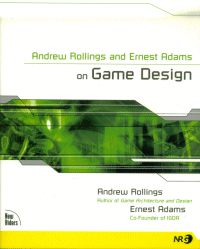| 'Andrew Rollings
and Ernest Adams on Game Design' by Andrew Rollings and Ernest Adams |
 |
| 'Andrew Rollings
and Ernest Adams on Game Design' by Andrew Rollings and Ernest Adams |
 |
I have to admit that I approached this book with more than a little cynicism. As a games designer I often get asked to comment on books about game design, and frankly most of them are crap. This time though I was pleasantly surprised - a well written book whose authors clearly know what they are talking about. This is not a book for those who 'want to get into the business', it is strictly about the art and science of game design. It's also not about games programming, a mistake 'game design' books often make. There is a world of difference between game design and program design. The book will appeal to those in the computer games business who are already games designers, or who are aiming to move sideways into games design. It will also appeal to anyone who just wants to find out how it's done. The book is in two sections. The first part covers general issues that crop up in games design, while the second half of the book is a systematic look each of the different game genres. The first part goes systematically through the elements of game design, covering the game setting or world, storytelling, character development, the user interface, gameplay, internal economy and game balance. I was broadly in agreement with the ideas developed in this section - with the notable exception of the treatment of emergence. I felt the authors didn't really understand emergence, and that their example was not, in fact, emergence at all! All the game designers I know (which is mostly multi-player ones) find emergence exciting. Significantly, no one has yet really figured out how to use it, probably because no one has yet figured out how to predict -what- will emerge. It may sound surprising, but games need to have a fair degree of predictability if they are going to succeed. At the moment emergence in games is a solution waiting for a problem on anything other than the very limited scale of things like flocking behaviour. While I wouldn't really have a use for the work sheets presented at the end of each chapter, I can see that they would be useful in a corporate environment. It was also nice to find that I'm not the only designer frustrated at the commercial pressures that mean compromises in my nice elegant design. :) In particular the book touched on the problems of a situation where the game (particularly a multi-player game) becomes unbalanced and starts to appeal to one type of player. If you rebalance it you stand a good chance of losing the existing player base before you build up a new one, with a consequent drop in income. What weaknesses there are tend to show up in the second half, which is a little uneven, reflecting the fact that the authors don't (understandably) have first hand experience of every genre. There is also something of a tendency to try to jam all the genres into the same mould - the one developed in the first half of the book. For instance, I would have liked to see a discussion of the problems of middle-game boredom in role playing games, but that didn't really fit into the framework. I'm sure anyone who has played such games has come across it. it's when you've more or less explored everything and you are just shuttling backwards and forwards across the game world, firing bigger fireballs at stronger enemies, while you build up your character stats for the final denouement. On the other hand I wish that I'd had access to the vehicle simulations chapter when I was designing Iron Wolves (a multi-player submarine simulation). It would have saved one hell of a lot of trial and error! The weakest part of the book is the chapter on multi-player games. There is a failure to realise that game technical and social management tools have to be part of the design - they can't be bolted on afterwards - boring, I know, but important. There is some discussion of the problems of toxic players, but it's fragmented and there is no unified framework to handle the problems involved. But these are not mega problems and they don't detract from the overall usefulness of the book. I've been designing persistent world multi-player games (not to mention a commercial single player game) for nearly 20 years, and there was much in the book that I found helped articulate and systematise my experience. Very useful indeed - it joins the very small number of books on games and game design that I've found worthy of space on my book shelf! (book supplied for review by ACCU)
Andrew Rollings and Ernest Adams on Game Design |
If you have any questions or comments about the articles on my web site, click here to send me email. |